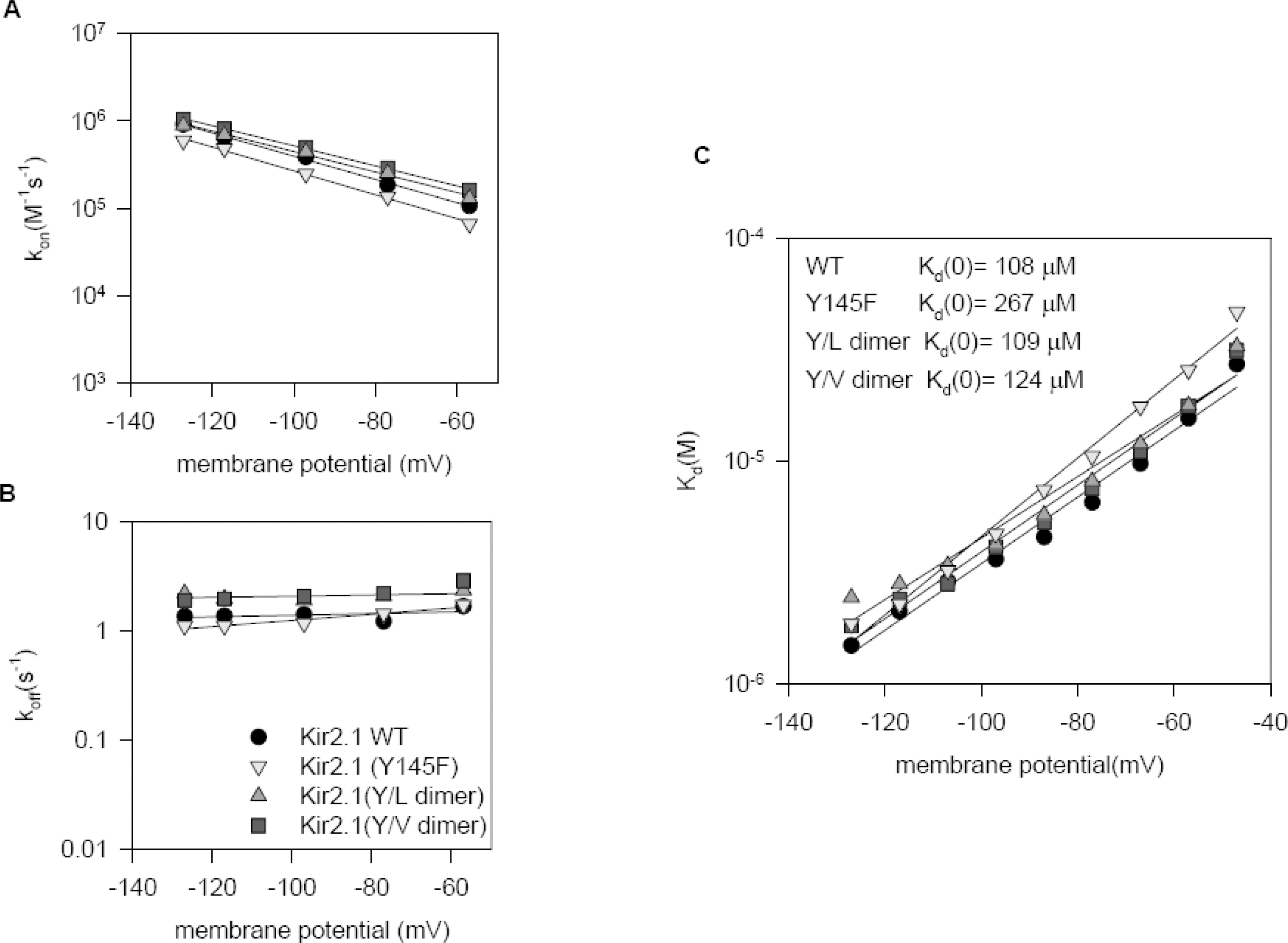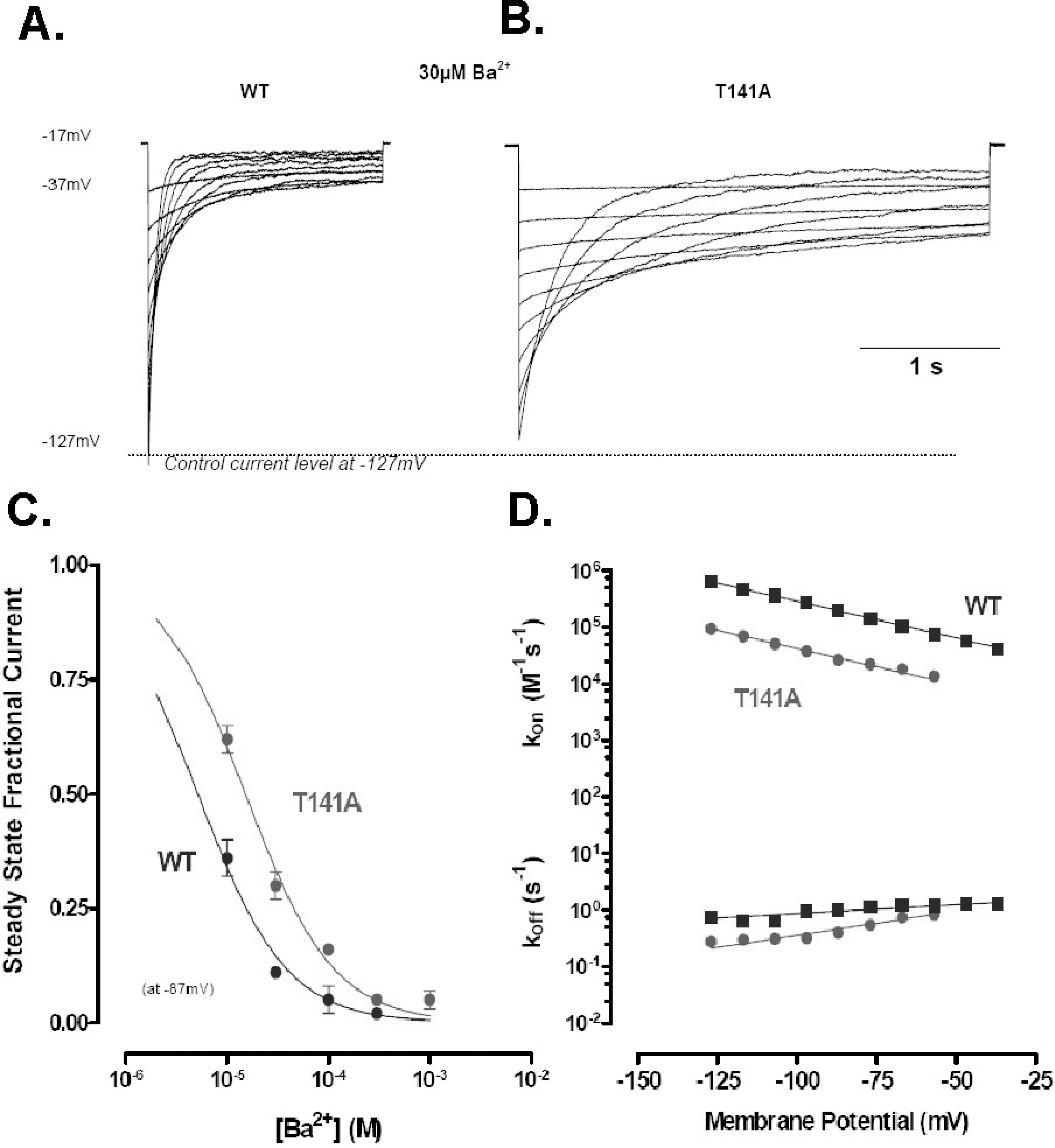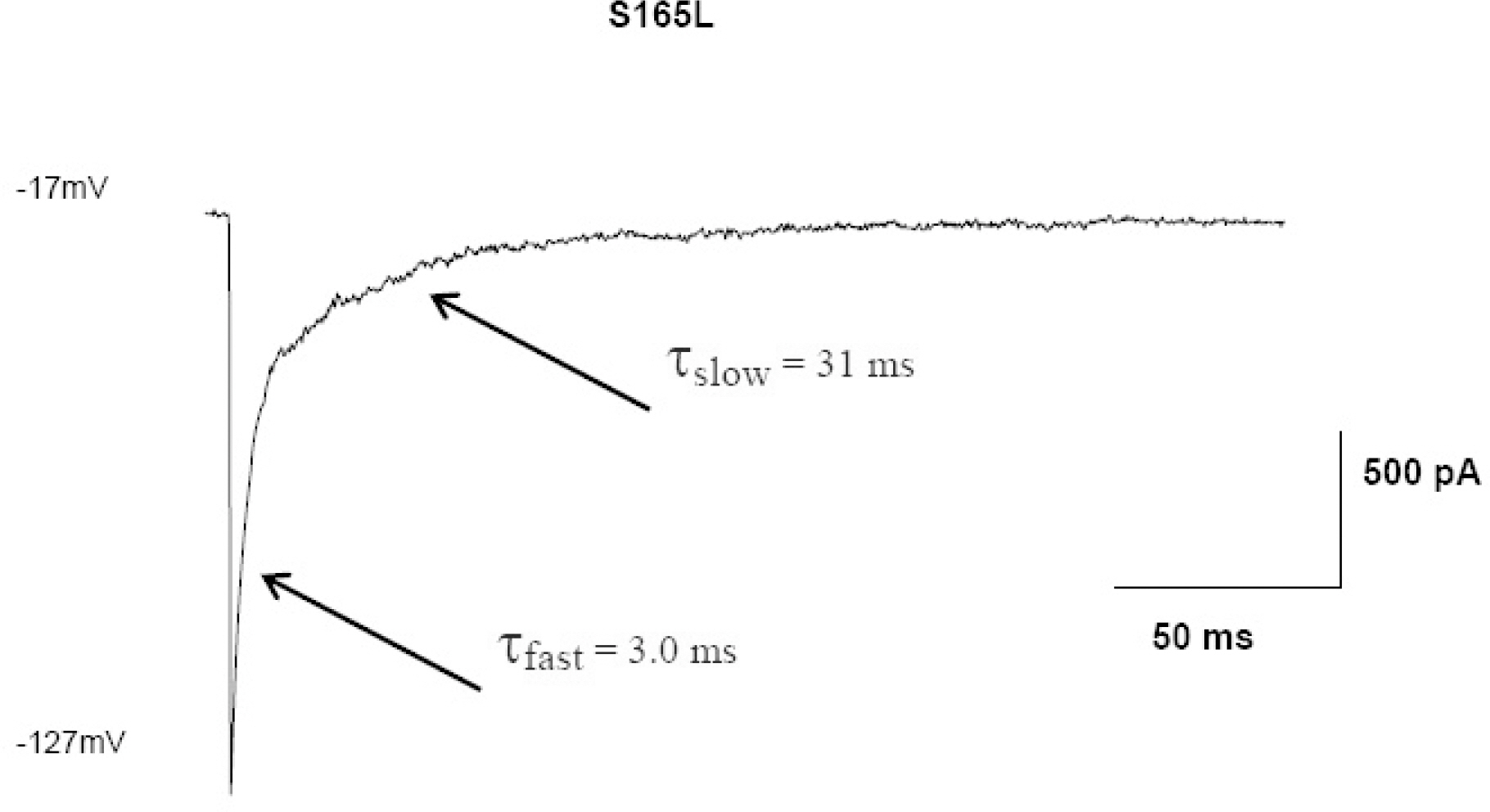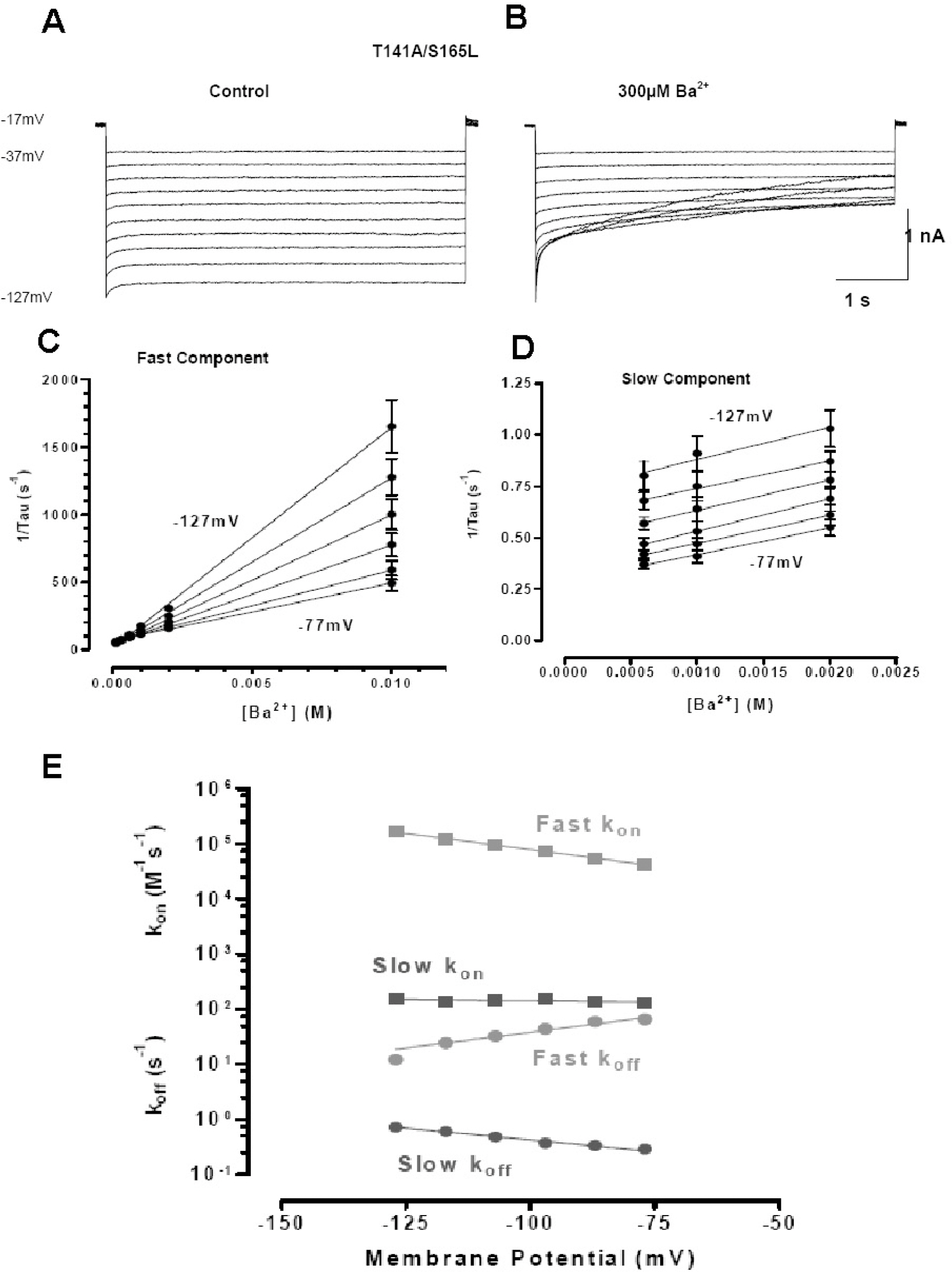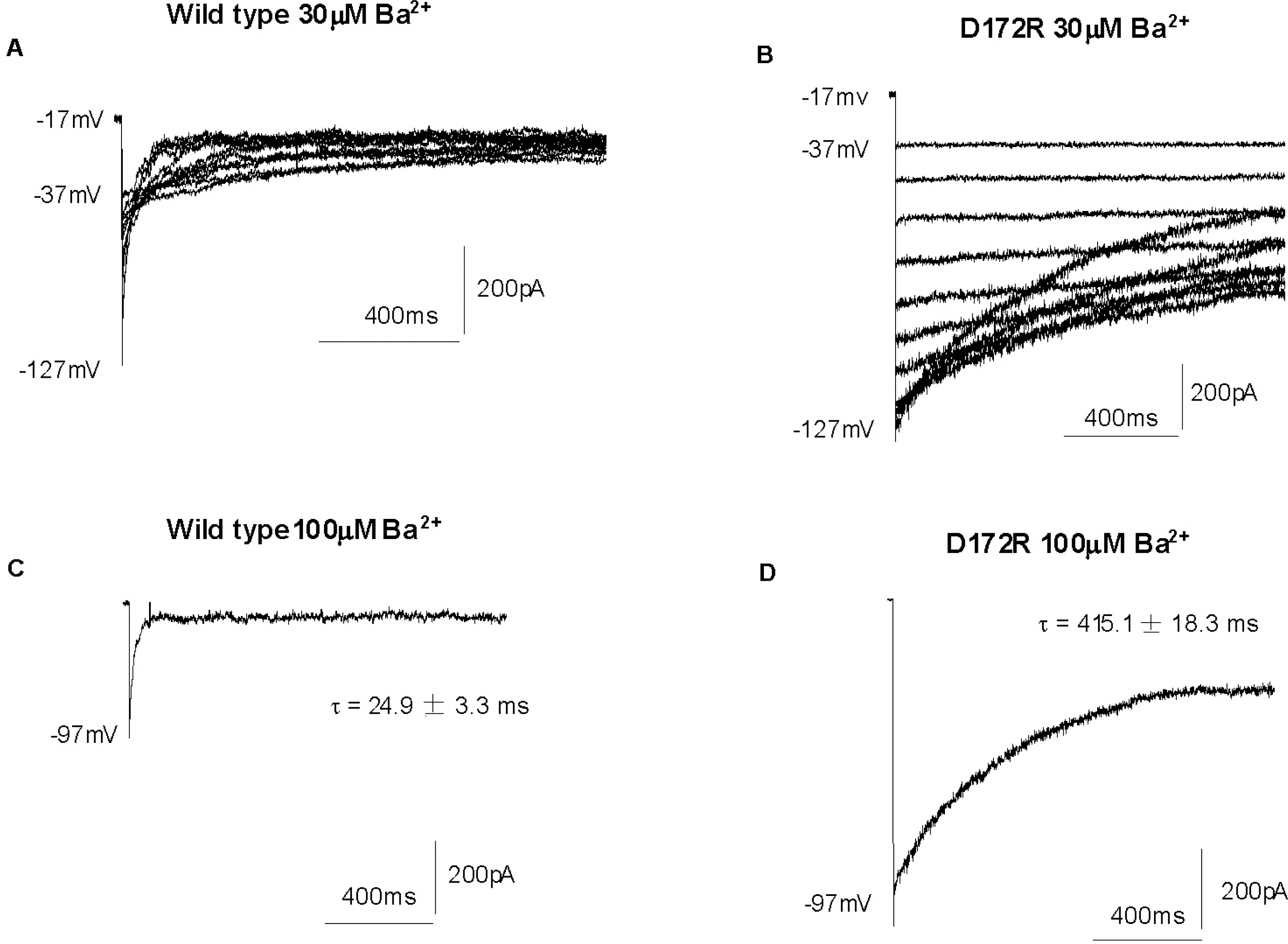Korean J Physiol Pharmacol.
2009 Feb;13(1):61-70. 10.4196/kjpp.2009.13.1.61.
Multiple Residues in the P-Region and M2 of Murine Kir 2.1 Regulate Blockage by External Ba2+
- Affiliations
-
- 1Department of Physiology and Biophysics, Seoul National University, College of Medicine, Seoul 110-799, Korea. stanfield@warwick.ac.uk, insuk@ plaza.snu.ac.kr
- 2Department of Biological Sciences, University of Warwick, Coventry CV4 7AL; Ion Channel Group, UK.
- 3Department of Cell Physiology & Pharmacology, University of Leicester, PO Box 138, Leicester, LE1 9HN, UK.
- 4Department of Biochemistry, University of L:eicester, LE1 7RH, UK.
- KMID: 2285373
- DOI: http://doi.org/10.4196/kjpp.2009.13.1.61
Abstract
- We have examined the effects of certain mutations of the selectivity filter and of the membrane helix M2 on Ba2+ blockage of the inward rectifier potassium channel, Kir 2.1. We expressed mutant and wild type murine Kir 2.1 in Chinese hamster ovary (CHO) cells and used the whole cell patch-clamp technique to record K+ currents in the absence and presence of externally applied Ba2+. Wild type Kir2.1 was blocked by externally applied Ba2+ in a voltage and concentration dependent manner. Mutants of Y145 in the selectivity filter showed little change in the kinetics of Ba2+ blockage. The estimated Kd(0) was 108micrometer for Kir2.1 wild type, 124micrometer for a concatameric WT-Y145V dimer, 109micrometer for a WT-Y145L dimer, and 267micrometer for Y145F. Mutant channels T141A and S165L exhibit a reduced affinity together with a large reduction in the rate of blockage. In S165L, blockage proceeds with a double exponential time course, suggestive of more than one blocking site. The double mutation T141A/S165L dramatically reduced affinity for Ba2+, also showing two components with very different time courses. Mutants D172K and D172R (lining the central, aqueous cavity of the channel) showed both a decreased affinity to Ba2+ and a decrease in the on transition rate constant (kon). These results imply that residues stabilising the cytoplasmic end of the selectivity filter (T141, S165) and in the central cavity (D172) are major determinants of high affinity Ba2+ blockage in Kir 2.1.
MeSH Terms
Figure
Reference
-
Abrams CJ., Davies NW., Shelton PA., Stanfield PR. The role of a single aspartate residue in ionic selectivity and block of a murine inward rectifier K+ channel Kir2.1. J Physiol. 493:643–649. 1996.Alagem N., Dvir M., Reuveny E. Mechanism of Ba2+ block of a mouse inwardly rectifying K+ channel: differential contribution by two discrete residues. J Physiol. 534:381–393. 2001.Dart C., Leyland ML., Barrett-Jolley R., Shelton PJ., Spencer PJ., Conley EC., Sutcliffe MJ., Stanfield PR. The dependence of Ag+ block of a potassium channel, murine Kir2.1, on a cysteine residue in the selectivity filter. J Physiol. 511:15–24. 1998.Doring F., Derst C., Wischmeyer E., Karschin C., Schneggenburger R., Daut J., Karschin A. The epithelial inward rectifier channel Kir7.1 displays unusual K+ permeation properties. J Neurosci. 18:8625–8636. 1998.Doyle DA., Morais CJ., Pfuetzner RA., Kuo A., Gulbis JM., Cohen SL., Chait BT., Mackinnon R. The structure of the potassium channel: molecular basis of K+ conduction and selectivity. Science. 280:69–77. 1998.Duprat F., Lesage F., Fink M., Reyes R., Heurateaux C., Lazdunski M. TASK, a human background K+ channel to sense external pH variations near physiological pH. EMBO J. 17:5464–5471. 1997.Fakler B., Brandle U., Bond CH., Glowatzki E., Konig C., Adelman JP., Zenner HP., Ruppersberg JP. A structural determinant of differential sensitivity of cloned inward rectifier K+ channels to intracellular spermine. FEBS Lett. 356:199–203. 1994.Fakler B., Brandle U., Glowatzki E., Weidemann S., Zenner HP., Ruppersberg JP. Strong voltage-dependent inward rectification of inward rectifier K+ channels is caused by intracellular spermine. Cell. 80:149–154. 1995.Ficker E., Taglialatela M., WIBLE BA., Henley CM., Brown AM. Spermine and spermidine as gating molecules for inward rectifier K+ channels. Science. 266:1068–1072. 1994.Hagiwara S., Miyazaki S., Moody W., Patlak J. Blocking effects of barium and hydrogen ions on the potassium current during anomalous rectification in the starfish egg. J Physiol. 279:167–185. 1978.
ArticleHagiwara S., Yoshii M. Effects of internal potassium and sodium on the anomalous rectification of the starfish egg as examined by internal perfusion. J Physiol. 292:251–265. 1979.
ArticleHarris RE., Larsson HP., Isakoff EY. A permanent ion binding site located between two gates of the Shaker K+ channel. Biophys J. 74:1808–1820. 1998.Heginbotham L., Lu Z., Abramson T., Mackinnon R. Mutations in the K+ channel signature sequence. Biophys J. 66:1061–1067. 1994.Hidalgo P., Mackinnon R. Revealing the architecture of a K+ channel pore through mutant cycles with a peptide inhibitor. Science. 268:307–310. 1995.Hurst RS., Toro L., Stefani E. Molecular determinants of external barium block in Shaker potassium channels. FEBS Lett. 388:59–65. 1996.Jiang Y., Mackinnon R. The barium site in a potassium channel by x-ray crystallography. J Gen Physiol. 115:269–272. 2000.
ArticleKrapivinsky G., Medina I., Eng L., Krapivinsky L., Yang Y., Clapham DE. A novel inward rectifier K+ channel with unique pore properties. Neuron. 20:995–1005. 1998.Kunkel TA. Rapid and efficient site-specific mutagenesis without phenotypic selection. Proc Natl Acad Sci USA. 82:488–492. 1985.
ArticleKuo A., Gulbis JM., Antcliff JF., Rahman T., Lowe ED., Zimmer J., Cuthbertson J., Ashcroft FM., Ezaki T., Doyle DA. Crystal structure of the potassium channel KirBac1.1 in the closed state. Science. 300:1922–1926. 2003.
ArticleLancaster MK., Dibb KM., Quinn CC., Leach R., Lee JK., Findlay JB., Boyett MR. Residues and mechanisms for slow activation and Ba2+ block of the cardiac muscarinic K+ channel, Kir3.1/Kir3.4. J Biol Chem. 275:35831–35839. 2000.Lee YM., Yang DK., Ashmole I., Stanfield PR., So I., Kim KW. Residues lining the pore region of the murine inward rectifier K+ channel (KIR2.1) control Ba2+ blockage. Biophysical J. 80:631A. 2001.Leech CA., Stanfield PR. Inward rectification in frog skeletal muscle fibres and its dependence on membrane potential and external potassium. J Physiol. 319:295–309. 1981.
ArticleLesage F., Guillemare E., Fink M., Duprat F., Lazdunski M., Romely G., Barhanin J. TWIK-1, a ubiquitous human weakly inward rectifying K+ channel with a novel structure. EMBO J. 15:1004–1011. 1996.Lockless SW., Zhou M., Mackinnon R. Structural and thermo-dynamic properties of selective ion binding in a K+ channel. PLoS Biology. 5:1079–1088. 2007.Lopatin AN., Makhina EN., Nichols CG. Potassium channel block by cytoplasmic polyamines as the mechanism of intrinsic rectification. Nature. 372:366–369. 1994.
ArticleLopatin AN., Makhina EN., Nichols CG. The mechanism of inward rectification of potassium channels: “long-pore plugging” by cytoplasmic polyamines. J Gen Physiol. 106:923–955. 1995.
ArticleLopatin AN., Nichols CG. [K+] Dependence of polyamine-induced rectification in inward rectifier potassium channels (IRK1, Kir2.1). J Gen Physiol. 108:105–113. 1996.Lu T., Ting AY., Mainland J., Jan LY., Schultz PG., Yang J. Probing ion permeation and gating in a K+ channel with backbone mutations in the selectivity filter. Nature Neurosci. 4:239–246. 2001.Matsuda H., Saigusa A., Irisawa H. Ohmic conductance through the inwardly rectifying K channel and blocking by internal Mg2+. Nature. 325:156–159. 1987.Minor DL., Masseling SJ., Jan YN., Jan LY. Transmembrane structure of an inwardly rectifying potassium channel. Cell. 96:879–891. 1999.
ArticleNavaratnam DS., Escobar L., Covarrubias M., Oberholtzer JC. Permeation properties and differential expression across the auditory receptor epithelium of an inward rectifier K+ channel cloned from the chick inner ear. J Biol Chem. 270:19238–19245. 1995.Neyton J., Miller C. Potassium blocks barium permeation through a calcium-activated potassium channel. J Gen Physiol. 92:549–567. 1988a.
ArticleNeyton J., Miller C. Discrete Ba2+ block as a probe of ion occupancy and pore structure in the high conductance Ca2+ activated K+ channel. J Gen Physiol. 92:569–586. 1988b.Nishida M., Cadene M., Chait BT., Mackinnon R. Crystal structure of a Kir3.1-prokaryotic Kir channel chimera. EMBO J. 26:4005–4015. 2007.
ArticleReuveny E., Jan YN., Jan LY. Contributions of a negatively charged residue in the hydrophobic domain of the IRK1 inwardly rectifying K+ channel to K+-selective permeation. Biophys J. 70:754–761. 1996.Sabirov RZ., Tominaga T., Miwa A., Okada Y., Oiki S. A conserved arginine residue in the pore region of an inward rectifier K channel (IRK1) as an external barrier for cationic blockers. J Gen Physiol. 110:665–677. 1997.
ArticleShieh RC., Chang JC., Arreola J. Interaction of Ba2+ with the pores of the cloned inward rectifier K+ channels Kir2.1 expressed in Xenopus oocytes. Biophys J. 75:2313–2322. 1998.Shioya T., Matsuda H., Noma A. Fast and slow blockades of the inward-rectifier K+ channel by external divalent cations in guinea-pig cardiac myocytes. Pflügers Arch. 422:427–435. 1993.So I., Ashmole I., Davies NW., Sutcliffe MJ., Stanfield PR. The K+ channel signature sequence of murine Kir2.1: mutations that affect microscopic gating but not ionic selectivity. J Physiol. 531:37–50. 2001.So I., Ashmole I., Soh H., Park CS., Spencer PJ., Leyland M., Stanfield PR. Intrinsic gating in inward rectifier potassium channels (Kir2.1) with low polyamine affinity generated by site directed mutagenesis. Kor J Physiol Pharmacol. 7:131–142. 2003a.So I., Ashmole I., Stanfield PR. The substates with mutants that negatively charged aspartate in position 172 was replaced with positive charge in murine inward rectifier potassium channel (murine Kir2.1). Kor J Physiol Pharmacol. 7:267–273. 2003b.Standen NB., Stanfield PR. A potential- and time-dependent blockade of inward rectification in frog skeletal muscle fibres by barium and strontium ions. J Physiol. 280:169–191. 1978.
ArticleStanfield PR., Davies NW., Shelton PA., Sutcliffe MJ., Khan IA., Brammar WJ., Conley EC. A single aspartate residue is involved in both intrinsic gating and blockage by Mg2+ of the inward rectifier, IRK1. J Physiol. 478:1–6. 1994.Stanfield PR., Nakajima S., Nakajima Y. Constitutively active and G-protein coupled inward rectifier K+ channels: Kir2.0 and Kir3.0. Rev Physiol Biochem Pharmacol. 145:47–179. 2002.Thompson GA., Passmore GM., Spencer PJ., Davies NW., Stanfield PR. Blockage of inward rectifier potassium channels (murine Kir2.1) by Ba2+ is influenced by an aspartate residue (D172). J Physiol. 511P:146P. 1998.Thompson GA., Leyland ML., Ashmole I., Sutcliffe MJ., Stanfield PR. Residues beyond the selectivity filter of the K+ channel Kir2.1 regulate permeation and block by external Rb+ and Cs+. J Physiol. 526:231–240. 2000a.Thompson GA., Leyland ML., Ashmole I., Stanfield PR. Residues in H5 and M2 of murine Kir2.1 regulate Ba2+ block. J Physiol. 526P:10S. 2000b.Topert C., Doring F., Wischmeyer E., Karschin C., Brockhaus J., Ballanyi K., Derst C., Karschin A. Kir2.4: a novel K+ inward rectifier channel associated with motoneurons of cranial nerve nuclei. J Neurosci. 18:4096–4105. 1998.Woodhull AM. Ionic blockage of sodium channels in nerve. J Gen Physiol. 61:687–708. 1973.
ArticleYang J., Jan YN., Jan LY. Determination of the subunit stoichiometry of an inwardly rectifying potassium channel. Neuron. 15:1441–1447. 1995.
ArticleZhou H., Chepilko S., Schutt W., Choe H., Palmer LG., Sackin H. Mutations in the pore region of ROMK enhance Ba2+ block. Am J Physiol. 271:C1949–C1956. 1996.
- Full Text Links
- Actions
-
Cited
- CITED
-
- Close
- Share
- Similar articles
-
- Association of Killer Cell Ig-like Receptor (KIR) with an Adaptor Protein Shc
- The Effect of External Divalent Cations on Intestinal Pacemaking Activity
- Regulation of Ba2+-Induced Contraction of Murine Ureteral Smooth Muscle
- Human diversity of killer cell immunoglobulin-like receptors and disease
- Human Leukocyte Antigen-C Genotype and Killer Immunoglobulin-like Receptor-Ligand Matching in Korean Living Donor Liver Transplantation



